Women's skirts in the 1920s marked a pivotal shift towards freedom and self-expression. Early in the decade, long, column silhouettes made way for mid-knee pleated and Gatsby styles, designed for movement. Fabrics varied from wool to silk taffeta, reflecting both practicality and the era's vibrant spirit with colors like apple green and powder blue. Skirts became essential in sports, aligning fashion with active lifestyles. By the late 1920s, fitted designs and separates emerged, showcasing versatility. This evolution not only transformed women's wardrobes but also symbolized independence, inviting discussions on the cultural impact of fashion in a rapidly changing world.
Evolution of Skirt Styles
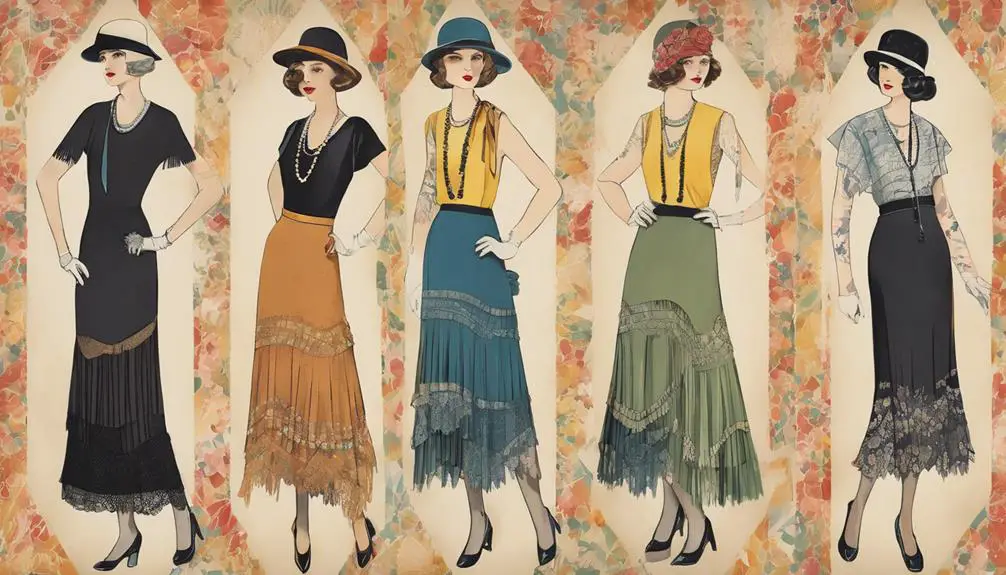
The evolution of skirt styles in the 1920s reflects a dramatic shift in women's fashion, characterized by both liberation and innovation. In the early part of the decade, skirts embraced long column silhouettes, often crafted from plaid fabrics that echoed traditional patterns while signaling a new era of freedom. This transformation was influenced by the movements of the time, as women sought greater independence and self-expression through their clothing choices, including vintage clothing characteristics. As you move into the mid-1920s, you'll notice the emergence of the pleated skirt, particularly the mid-knee Gatsby skirts, which introduced a playful element, allowing women to move with ease and grace.
Fabrics and Colors of the Era
As you explore the fabrics and colors of the 1920s, you'll uncover a fascinating interplay between texture and hue that defined women's skirts during this transformative decade. The era saw a diverse array of materials, with wool often favored for winter skirts due to its warmth. In contrast, silk taffeta, gabardine, and linen emerged as lighter options for the summer months, emphasizing comfort and versatility.
The color palette was mainly characterized by dull tones, yet splashes of vibrant shades like apple green and powder blue reflected the vivacity of the Jazz Age. Patterns played a significant role, with plaid, stripes, and checks frequently appearing in designs, showcasing innovative combinations that added character to skirts.
Decorative elements were essential, too; pleated skirts, for instance, enhanced movement and visual interest, allowing women to express their individuality. This blend of fabrics and colors not only catered to the practical needs of different seasons but also embraced the bold spirit of the decade. Ultimately, the fabrics and colors of the 1920s encapsulated a dynamic fashion landscape that balanced elegance with a sense of liberation.
Skirts in Sports and Leisure
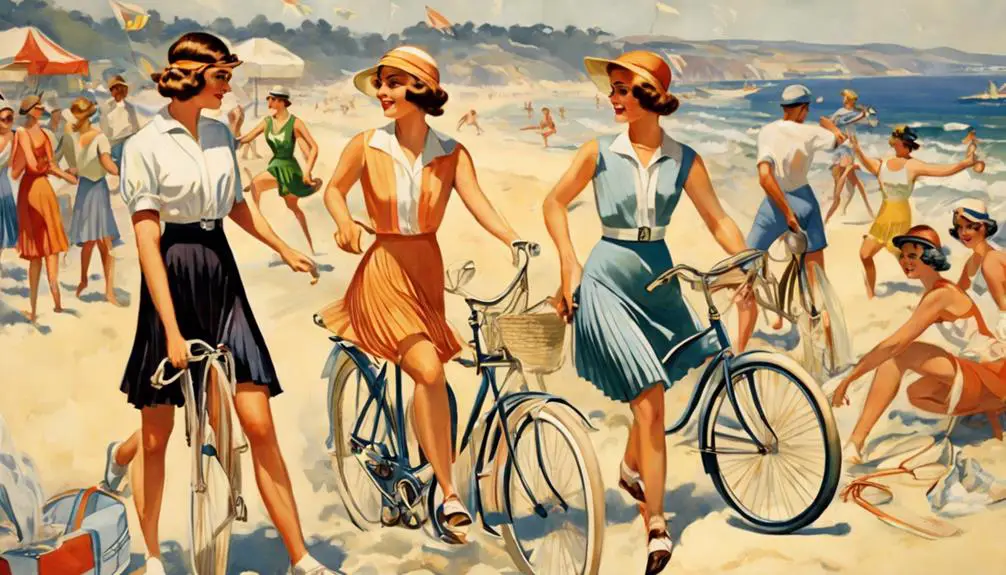
Emerging from the vibrant fabric landscape of the 1920s, skirts took on a new significance in the domain of sports and leisure. As women increasingly participated in activities like golf, tennis, and bowling, skirts became integral to sports uniforms, merging style with functionality. The mid-1920s introduced pleated skirts, designed to allow for ease of movement while maintaining a fashionable appearance. These skirts were perfect for active wear, enabling women to engage in sports without sacrificing their sense of style.
The rise of two-piece outfits further transformed women's leisure wear. Skirts paired with blouses or sweaters created a sporty look that appealed to young women seeking both comfort and fashion. Jumper dresses and suspender skirts emerged as trendy options, reflecting a playful and active lifestyle. Knit two-piece dresses, often crafted from jersey fabric, offered a casual daywear alternative, featuring knee-length skirts that balanced style and practicality.
In this era, skirts not only represented a shift in women's fashion but also symbolized a broader cultural movement towards greater freedom and active participation in society, making them a defining element of women's wardrobes in the 1920s.
Fashion Trends of the Late 1920s
By the late 1920s, women's fashion experienced a notable transformation as skirt styles evolved to reflect a blend of elegance and practicality. You'd see long skirts and midi skirts becoming increasingly popular, emphasizing fitted designs that exuded sophistication while maintaining comfort. This shift often paired skirts with tailored jackets, creating a polished look suitable for various occasions.
The era also introduced innovative styles, like draping and asymmetrical hemlines, which allowed for bolder, more artistic silhouettes. These creative elements showcased women's desire for personal expression in their fashion choices. At the same time, the "Tom Boy" look emerged, characterized by button-down shirts and sporty skirts, marking a change toward more casual, relaxed attire.
Separates, particularly skirt and blouse combinations, surged in popularity, reflecting a growing emphasis on versatility and individual style. This trend mirrored changing societal norms, as women sought both comfort and fashion. As the decade drew to a close, economic changes prompted a shift back to lower calf lengths, signaling a new chapter in women's fashion just as the stock market crash of 1929 reshaped the world.
Shopping for Vintage Skirts
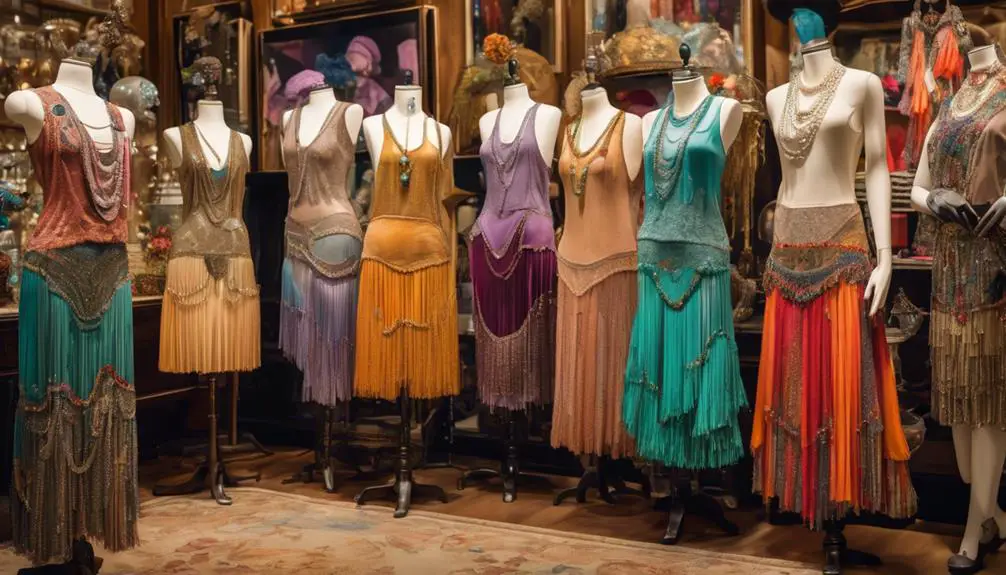
Shopping for vintage skirts can be an exciting journey, especially when you know what to look for. Begin by exploring reputable merchants who specialize in vintage and retro clothing. Thrift stores and vintage shops often house authentic 1920s-inspired skirts that capture the essence of the decade. Additionally, understanding the importance of tag identification can enhance your appreciation for the garments you find. Keep in mind that sizing can vary considerably from modern standards, so always check size charts and product descriptions to guarantee a proper fit.
Understanding the historical context of 1920s fashion enhances your ability to style these skirts accurately, especially for vintage-themed events. You can create a unique personal style by mixing vintage and modern pieces. For instance, pairing a vintage skirt with a contemporary blouse allows you to honor retro aesthetics while staying fashionable.
Attention to detail is vital; complement your vintage skirts with carefully chosen accessories like hats, shoes, and jewelry. These elements can elevate your look and enhance the overall vintage vibe. By knowing what to seek out and how to style your finds, you'll not only enjoy shopping for vintage skirts but also embrace a timeless fashion statement that reflects your individuality.
Cultural Impact of 1920s Fashion
The cultural impact of 1920s fashion, particularly through women's skirts, marked a pivotal moment in societal evolution, reflecting a newfound sense of freedom and self-expression. As skirts shifted to knee-length, they symbolized the liberation of women in a post-World War I world. This alteration, epitomized by flapper fashion and vibrant styles, allowed women to embrace a more active lifestyle, dancing to jazz rhythms in skirts made from materials like plaid wool.
Initially, society viewed the shorter skirt with skepticism, concerned about modesty. However, as women adopted this trend, it became a powerful symbol of modernity and independence. The Art Deco movement also influenced fashion, promoting geometric patterns and bold colors that expressed a break from traditional norms.
This era laid the groundwork for future fashion revolutions, challenging established gender roles. By donning these skirts, women not only showcased their evolving identity but also ignited discussions about women's rights. The cultural resonance of 1920s fashion is undeniable, illustrating how clothing can reflect and shape societal attitudes, paving the way for more progressive movements in the decades to follow.
Frequently Asked Questions
What Skirts Were Popular in the 1920s?
In the 1920s, you'd notice pleated skirts and Gatsby skirts dominating fashion, offering comfort and style. Handkerchief hems added flair, while hemlines shifted from ankle-length to knee-length, symbolizing a newfound sense of liberation for women.
How Did Flappers Dress in the 1920s?
You'd notice flappers dressed in knee-length, drop-waist dresses, embracing a boyish silhouette. Their outfits, often adorned with pleats and beading, reflected a lively spirit, pairing with cropped jackets for a modern, youthful aesthetic.
What Is the Term for a Fashionable Woman From the 1920S Who Wore Short Skirts and Went Against Traditional Behavior?
The term you're looking for is "flapper." These fashionable women of the 1920s challenged societal norms with their daring attire, including short skirts, bobbed hair, and bold makeup, embodying a spirit of liberation and modernity.
When Did Women's Skirts Get Shorter?
You'll notice skirts started getting shorter in the early 1920s, reflecting a cultural shift. By 1926, they reached knee-length, symbolizing liberation and modernity, before dropping again after the 1929 stock market crash.


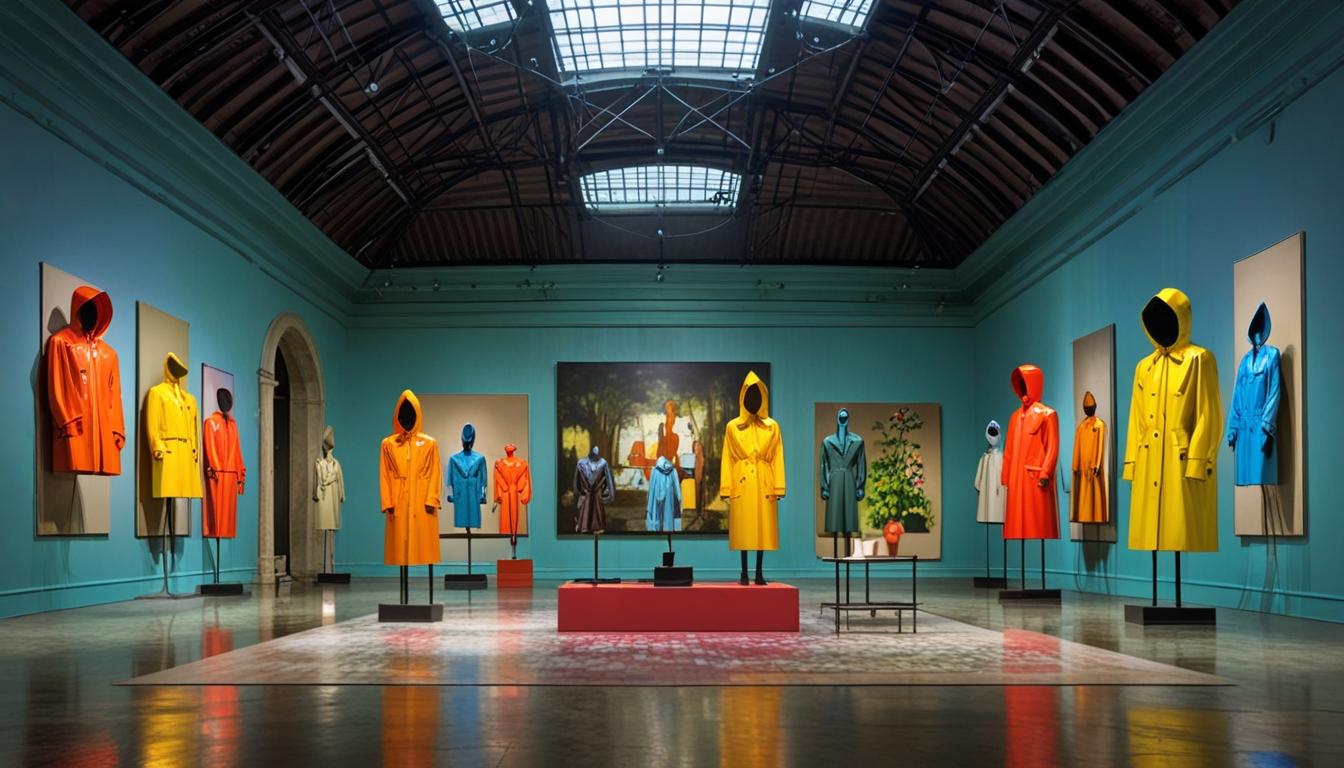
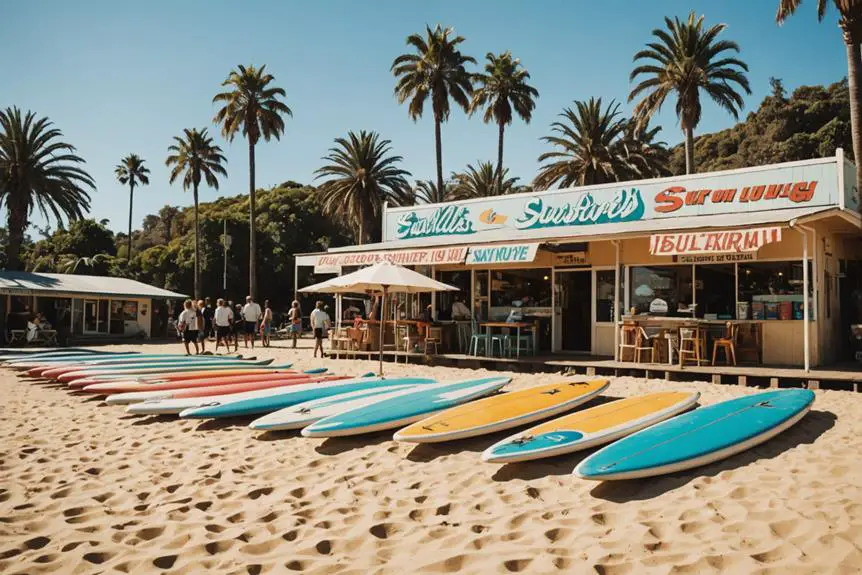
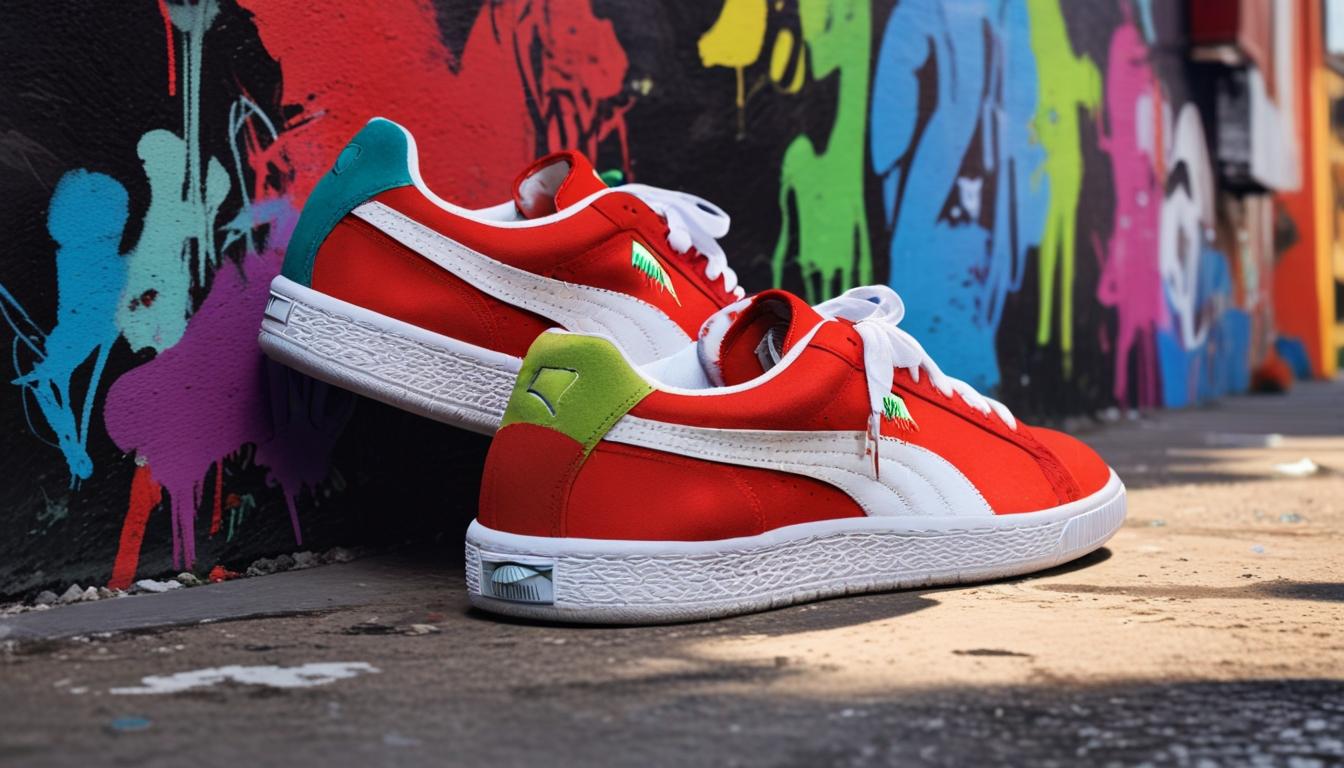
It is best to participate in a contest for top-of-the-line blogs on the web. I’ll recommend this web site!